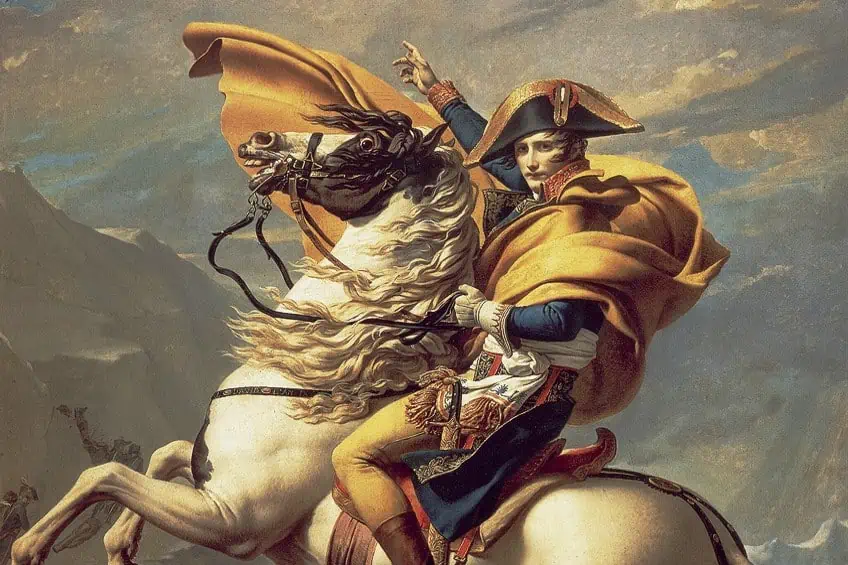“Napoleon Crossing the Alps” by Jacques-Louis David – Analysis
While you have most likely seen this famous painting of Napoleon at Saint Bernard’s Pass on many occasions, have you ever wondered who painted the famous picture of Napoleon crossing the Alps? Napoleon Crossing the Alps by Jacques-Louis David is regarded among the artist’s most well-known paintings. The original painting of Napoleon Bonaparte was produced in 1801, but four further versions were subsequently produced. Let’s learn more about this famous artwork as we take a look at the Napoleon Crossing the Alps analysis and history.
The History of Napoleon Crossing the Alps by Jacques-Louis David
| Artist | Jacques-Louis David (1748 – 1825) |
| Date | 1801 (first version) |
| Medium | Oil on canvas |
| Dimensions (cm) | 261 x 221 |
| Current Location | Château de Malmaison, Rueil-Malmaison, France |
Napoleon at Saint Bernard Pass is a defining moment in history. It is, therefore, not surprising that there were those who sought for it to be captured on canvas. The composition, which was originally commissioned to be painted by the King of Spain, depicts a highly romanticized portrayal of Napoleon crossing over the Alps in May 1800. Below, Let’s discover everything you need to know about the background of this painting and the versions that followed.
Background of the Painting of Napoleon Bonaparte
Napoleon made a decision to head back to Italy to strengthen the French forces in the nation and regain the territory won by the Austrians in the preceding years after assuming power in France on the 9th of November 1799. Napoleon commanded the Reserve Army over the mountains of the Alps in the spring of 1800. The Austrian soldiers, led by Michael von Melas, were besieging Masséna in Genoa, and Napoleon intended to obtain an advantageous position by utilizing the Trans-Alpine route. Genoa had surrendered by the time Napoleon’s men arrived, but he pressed on, hoping they could confront the Austrians before they could reorganize themselves.
On the 9th of June, the Reserve Army engaged in a battle at Montebello before achieving an important victory at the Battle of Marengo.
Napoleon Bonaparte’s appointment as First Consul, as well as the French triumph in Italy, led to a reconciliation with Charles IV of Spain. A customary exchange of gifts took place while efforts to re-establish diplomatic relations were ongoing. Charles was given pistols made in Versailles, gowns from the greatest Parisian dressmakers, diamonds to be given to the queen, and a magnificent piece of armor for Manuel Godoy, the recently reappointed Prime Minister. In exchange, Napoleon Bonaparte was given 16 highly-valued Spanish horses from the royal stables, paintings of the monarchy by Goya, and a commission from Jacques-Louis David.
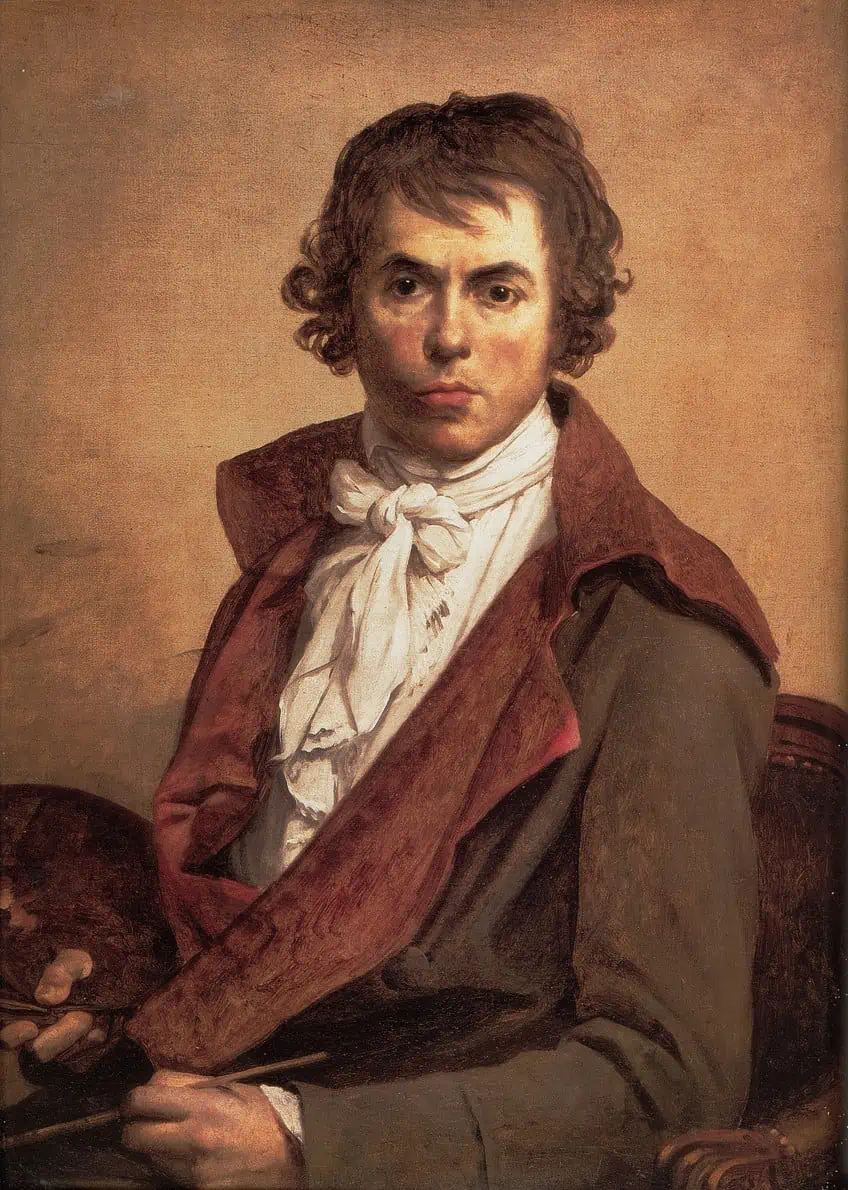
Charles-Jean-Marie Alquier, the French ambassador to Spain, was tasked with procuring an artwork from Jacques-Louis David on behalf of the king. The painting was to hang in Madrid’s Royal Palace as a symbol of the two nations’ new alliance. The artist, who had been a staunch supporter of the Revolution but had shifted his allegiance to the new Consulate, was excited to take on the assignment. When Bonaparte learned of the request, he directed David to create three additional versions: one for the Les Invalides library, another for the Château de Saint-Cloud, and the last one for the Royal Palace of Milan, the seat of the Cisalpine Republic.
David created a fifth version, which resided in his various studios until his passing.
The Five Various Versions of the Painting of Napoleon Bonaparte
The first artwork that was produced stayed in Madrid until around 1812 when Joseph Bonaparte took it after abdicating as Spain’s king. After he went into exile in America, he brought it with him and displayed it at his Point Breeze house in New Jersey. The artwork was passed down through his family until 1949 when it was presented to the Château de Malmaison museum by his great-grandniece, Eugenie Bonaparte.
The version of Napoleon at Saint Bernard Pass created for the Château de Saint-Cloud was taken in 1814 by Prussian troops led by von Blücher and presented to the King of Prussia, Frederick William III. It is currently housed at Charlottenburg Palace in Berlin.
The version produced in 1802 from Les Invalides was removed and stored during the Bourbon Restoration in 1814, but was subsequently rehung in 1837 under the direction of Louis-Philippe in his newly designated museum at the Palace of Versailles, where it continues to be displayed to this day. The version produced in 1803 was transported to Milan but was seized by the Austrians in 1816. Milanese residents refused to part with it, and it stayed in the city until 1825. In 1834, it was finally displayed in the Belvedere in Vienna. It is still there today, as part of the Austriaische Galerie Belvedere’s collection.
The version that the artist kept till his death in 1825 was displayed in 1846 at the Bazar Bonne-Nouvelle. His daughter, Pauline Jeanin, donated it to the future Napoleon III in 1850, upon which it was hung in the Tuileries Palace. The painting was then subsequently presented to the Palace of Versailles museum in 1979.
Napoleon Crossing the Alps Analysis
The original commission was for a depiction of Napoleon dressed in his First Consul attire, perhaps in the style of later portraits, but David was eager to create an equestrian setting. Ignacio Muzquiz, the Spanish ambassador, notified Bonaparte and asked how he wanted to be portrayed.
He initially wanted to be portrayed inspecting the troops, but he eventually decided to be depicted crossing the Alps.
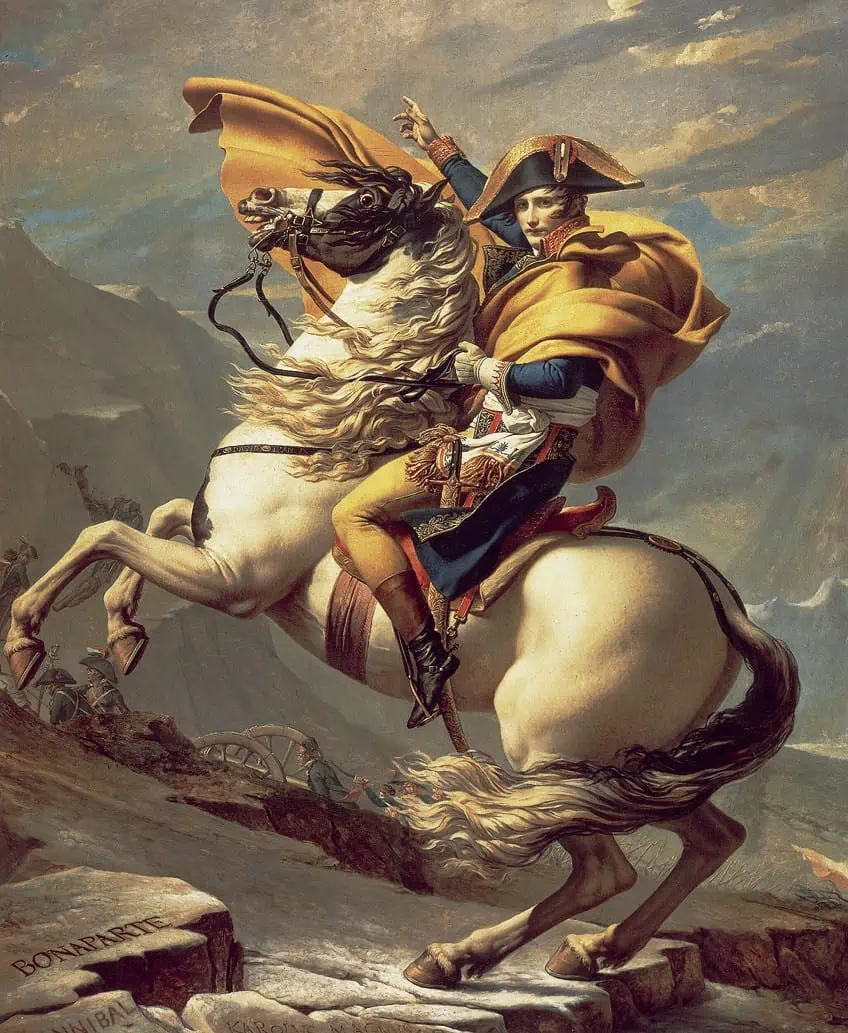
In reality, the journey had been carried out in good weather, and Napoleon was led through by a guide a few days after the army while riding on a mule. Nevertheless, the painting of Napoleon Bonaparte was always intended to be propaganda, and Bonaparte instructed the artists to depict him “calm, seated atop fiery steed”, and it is likely that he further suggested including the names of the other outstanding commanders who had led the troops across the Alps: Charlemagne and Hannibal.
Production of the Painting of Napoleon Bonaparte
Contrary to David’s usual process, few drafts and preliminary studies were created. Gros, David’s pupil, created a little oil sketch of a horse being reined in, and it was most likely a study for Napoleon’s mount, and the artist’s notebooks have some drawings of preliminary ideas on the rider’s stance. The absence of early sketches could be explained in part by Bonaparte’s unwillingness to pose for the picture. He had sat for Gros at the request of Joséphine de Beauharnais in 1796, but he had claimed that it had not had sufficient time for the sitting to be beneficial.
In 1798, David persuaded him to pose for a portrait, but the few hours that the twitchy and irritated Bonaparte permitted him were insufficient to achieve an acceptable likeness.
When David accepted the commission for the Alpine setting, it seems like he expected Bonaparte to sit for the study, but he flatly refused, not just because he detested sitting for portraits, but also because he argued that the work of art should be a depiction of his character instead of his outward appearance. The unwillingness to participate in a sitting signaled a shift in Napoleon’s portraiture in general, with realism giving way to political iconography: portraiture after this moment was iconic, conveying an idealized version of a person instead of a physical likeness.

In order to get Napoleon to pose for the portrait, David used a bust as the foundation for his facial features and had his son stand on the top of a ladder as an example for his pose. The clothing is authentic since David was able to obtain Bonaparte’s uniform at Marengo. The very first of five paintings was completed in four months, taking from October 1800 through to January 1801, to complete. After finishing the first version, David instantly started working on the second, which was completed on the 25th of May, the date of Bonaparte’s examination of the images at David’s studio.
Jérôme-Martin Langlois, who worked mostly on the first two portraits, and George Rouget, who focused on the version for Les Invalides, were two of David’s students who helped him in creating the various copies.
Technique Used in the Painting of Napoleon Bonaparte
Unlike his predecessors Jean-Honoré Fragonard and François Boucher, who utilized a gray or red undercoat as a base color to build up the work of art, David used the canvas’ white background directly underneath his colors, as evidenced by his initial attempt at a painting of Bonaparte or the drawing of the Tennis Court Oath. David used several coats of paint to achieve his desired look.
He would flesh out the picture with gentle touches, using a brush with minimal paint and focusing on the blocks of light and shadow instead of the details, after capturing the basic contour with an ochre sketch.
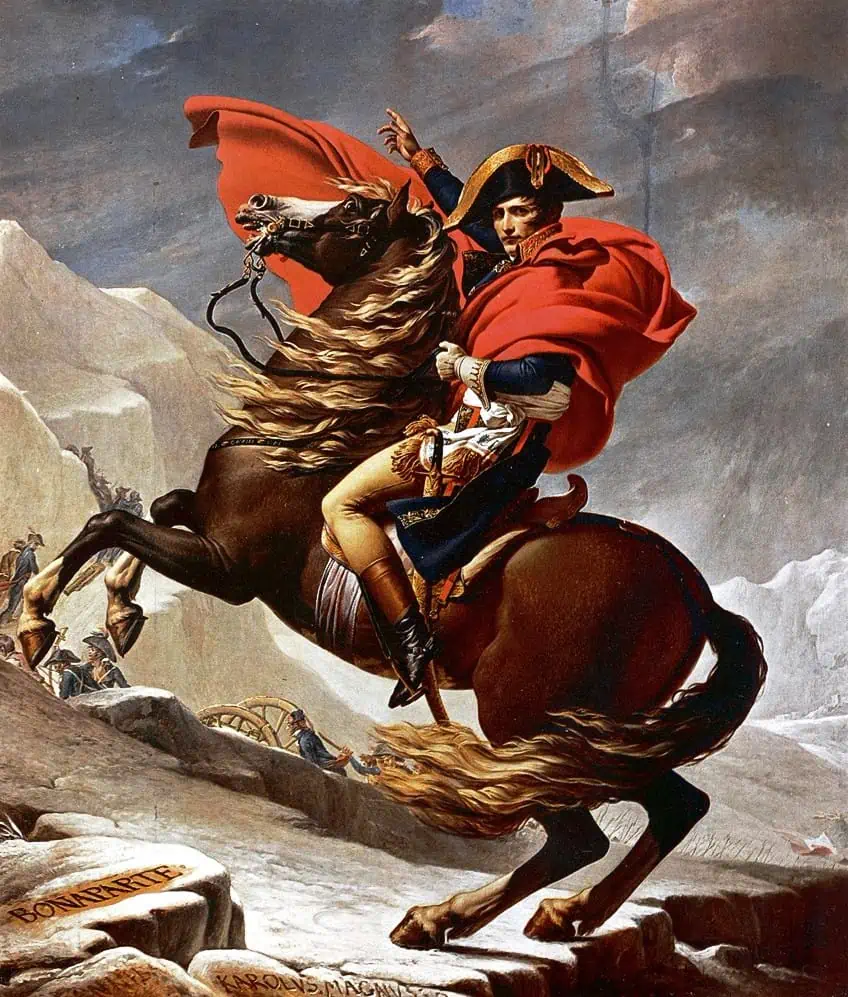
The rendition of the painting which was located in Malmaison demonstrates the impact of this technique, particularly in how the horse’s rump was treated. David focused on filling in the details and addressing any flaws in the second layer. The final layer that he applied was used for final touches such as tone mixing and surface smoothing. David usually delegated this work to his assistant artists.
Details of the Painting of Napoleon Bonaparte
All five versions are around the same size. Bonaparte is featured mounted in a general-in-chief’s uniform, sporting a gold-trimmed bicorne and wielding a Mamluk-style saber. He is enveloped by the pleats of a big cloak that billows in the breeze. His gaze falls on the observer, and he points with his right hand toward the mountain’s peak. His left hand is gripping the reins of his horse. The same wind that lifts Napoleon’s cloak also pushes the horse’s tail and mane against its body as it stands on its hind legs. A line of troops intermingled with artillery, makes its way up the side of the mountain in the distance.
Bonaparte wears an orange cloak, while the girth around the horse’s belly is a dark faded crimson in the original version.
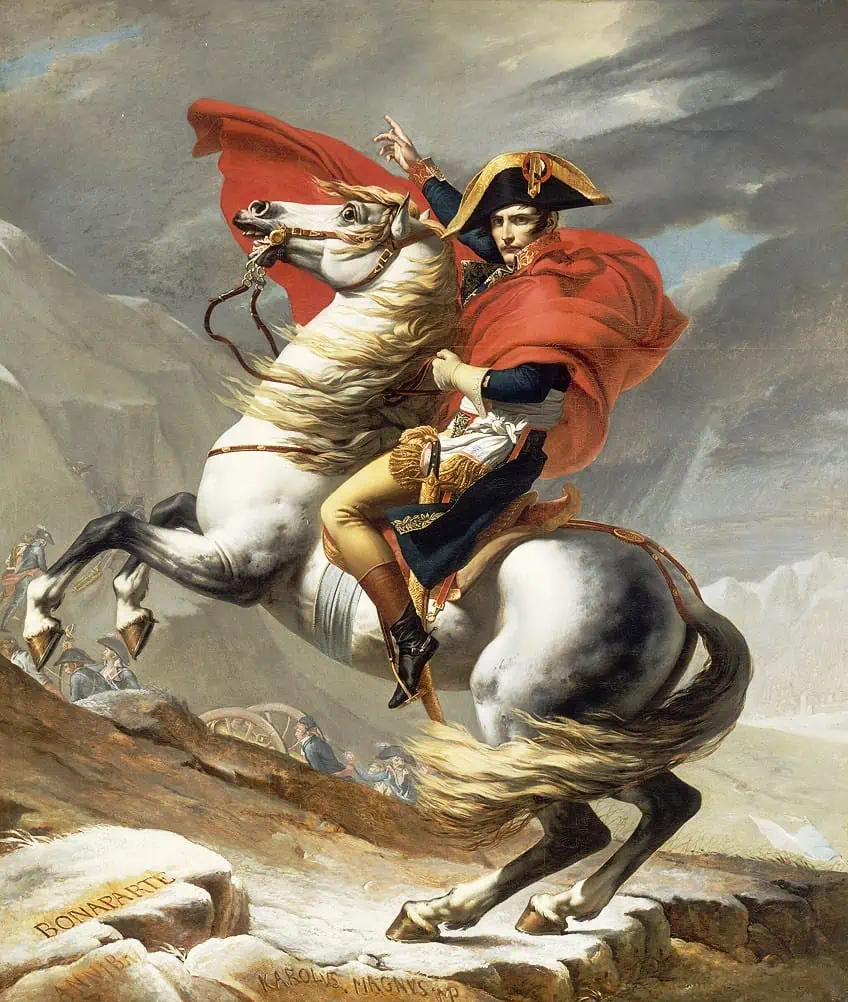
In the Charlottenburg version, Napoleon wears a crimson robe and rides a chestnut horse. The horse in the first version made in Versailles is speckled gray, its gear is exactly the same as the version produced for Charlottenburg, and the girth is a blue color. The second version from Versailles depicts a black and white horse with full equipment but no martingale.
As we have discovered, there was not only one painting of Napoleon Bonaparte produced by Jacques-Louis David, but actually five versions in total. While it may be a very majestic-looking piece of art, it is far from historically accurate. Even though it depicts Napoleon leading his men across the Alps, bravely and calmly riding atop a massive and fierce-looking horse, he actually only crossed after the troops had already traversed, and was guided by a local on a mule! Since that is hardly an image worth painting, David livened it up somewhat to better serve as a work of propaganda.
Frequently Asked Questions
How Was the Painting of Napoleon Bonaparte Received?
While there was a backlash in the media over the purchase, the first two copies of Napoleon Crossing the Alps by Jacques-Louis David were exhibited in the Louvre. The painting quickly gained notoriety because of the multiple copies that were created, with the image appearing everywhere from postage stamps to posters. It soon rose to the top of Napoleon’s most-reproduced images. With this piece, the artist Jacque-Louis David reached the pinnacle of the horse portraiture genre. With the possible exception of Théodore Géricault’s 1812 painting The Charging Chasseur, no other horse picture created during Napoleon’s reign attracted such notoriety.
Who Painted the Famous Picture of Napoleon Crossing the Alps?
The painting you are looking for is called Napoleon Crossing the Alps by Jacques-Louis David. In fact, he did not only create one version of this painting, as there are another four different versions in existence! Bonaparte, of course, wanted a few for himself, and even the artist held on to one of the versions, which stayed in his studio until his passing.
Jordan Anthony is a Cape Town-based film photographer, curator, and arts writer. She holds a Bachelor of Art in Fine Arts from the University of the Witwatersrand, Johannesburg, where she explored themes like healing, identity, dreams, and intuitive creation in her Contemporary art practice. Jordan has collaborated with various local art institutions, including the KZNSA Gallery in Durban, the Turbine Art Fair, and the Wits Art Museum. Her photography focuses on abstract color manipulations, portraiture, candid shots, and urban landscapes. She’s intrigued by philosophy, memory, and esotericism, drawing inspiration from Surrealism, Fluxus, and ancient civilizations, as well as childhood influences and found objects. Jordan is working for artfilemagazine since 2022 and writes blog posts about art history and photography.
Learn more about Jordan Anthony and about us.
Cite this Article
Jordan, Anthony, ““Napoleon Crossing the Alps” by Jacques-Louis David – Analysis.” artfilemagazine – Your Online Art Source. October 20, 2023. URL: https://artfilemagazine.com/napoleon-crossing-the-alps-by-jacques-louis-david/
Anthony, J. (2023, 20 October). “Napoleon Crossing the Alps” by Jacques-Louis David – Analysis. artfilemagazine – Your Online Art Source. https://artfilemagazine.com/napoleon-crossing-the-alps-by-jacques-louis-david/
Anthony, Jordan. ““Napoleon Crossing the Alps” by Jacques-Louis David – Analysis.” artfilemagazine – Your Online Art Source, October 20, 2023. https://artfilemagazine.com/napoleon-crossing-the-alps-by-jacques-louis-david/.


